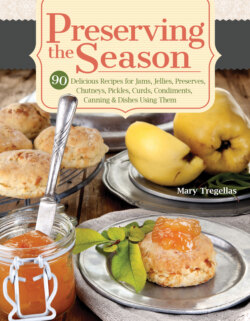Читать книгу Preserving the Season - Mary Tregellas - Страница 9
A note on ingredients
ОглавлениеFruit and Vegetables
There is a common misconception that second-rate fruit is suitable for jam—not so. For jam-and jelly-making, fruit should be just ripe or slightly underripe, so that the flavor is at its best, and the pectin content has not started to wane. Riper fruit and vegetables are suitable for chutneys, ketchups, and cordials.
Rinse and prepare produce just before using; drain and dry well. Discard any squashy berries, and cut away bruises from hard fruits. Frozen produce is great for preserves: cook from frozen and adjust the cooking time accordingly.
Try to obtain at least some of your fruit and vegetables locally. Gardens, pick-your-own farms, and farmers’ markets are good places to start. Barter with your friends and neighbors—you are sure to find someone with produce to spare.
Sugars
It is the magical combination of sugar, acid, and pectin that makes a good set. A high proportion of sugar also acts as a preservative, so don’t be tempted to reduce the amount.
High-pectin fruits include cooking apples, redcurrants, blackcurrants, quinces, cranberries, gooseberries, and damsons; medium-pectin fruits include raspberries, apricots, plums (including greengage plums), and, early blackberries; and low-pectin fruits are cherries, strawberries, pears, late blackberries, peaches, and rhubarb.
For jams, jellies, marmalades, and cordials, white granulated sugar serves most purposes, although brown sugar is delicious in marmalades. You can buy sugar that contains added pectin, which is useful with fruits that are low in natural pectin, such as strawberries and cherries. Preserving sugar (which does not contain pectin), sometimes recommended for use with high-pectin fruits, has larger crystals and supposedly makes the clearest preserves, though I never use it.
For chutneys and sauces, various types of brown sugar (demerara, light, and dark muscovado) are more commonly used, giving a deeper color and flavor, though white granulated sugar works too.
Cold Remedy
As well as its uses in chutney-making, cider vinegar is a magical ingredient for curing all kinds of ills. My mother’s favorite cure for colds and flu was to drink hot cider vinegar and honey. Put two teaspoons of cider vinegar in a mug with a level tablespoon of honey. Top up with boiling water and stir until the honey is dissolved. Sip the hot drink slowly, inhaling the steam as you do so.
Spices
Key ingredients in chutneys and sauces, spices give warmth, heat, and fragrance to any recipe. Ready-ground spices are convenient but a little less aromatic. When using whole spices, either tie them in muslin or place in a spice ball and let them swim around in the preserve, infusing it with their flavor; or, for the most flavorsome and potent results, toast the spices in a dry frying pan for 2–3 minutes, and then grind in a spice mill or with a pestle and mortar and add to the preserve.
Vinegars
Vinegar’s acidity gives it the power to preserve, since microorganisms cannot grow in an acidic environment. Most types of vinegar are suitable for savory preserves. Red and white wine vinegars are good all-rounders and work well in most recipes. Strong-tasting malt vinegars have long been used in preserving. Clear distilled malt vinegar is a good choice if you want to keep the color of the original ingredients. Cider vinegar has a fruity taste, and is slightly less acidic than wine and malt varieties. Balsamic vinegar has a lower acidity, so it is not suitable as a preservative, though it can be added for flavor.
